Canada Diabetes Care Drugs & Devices Market Size
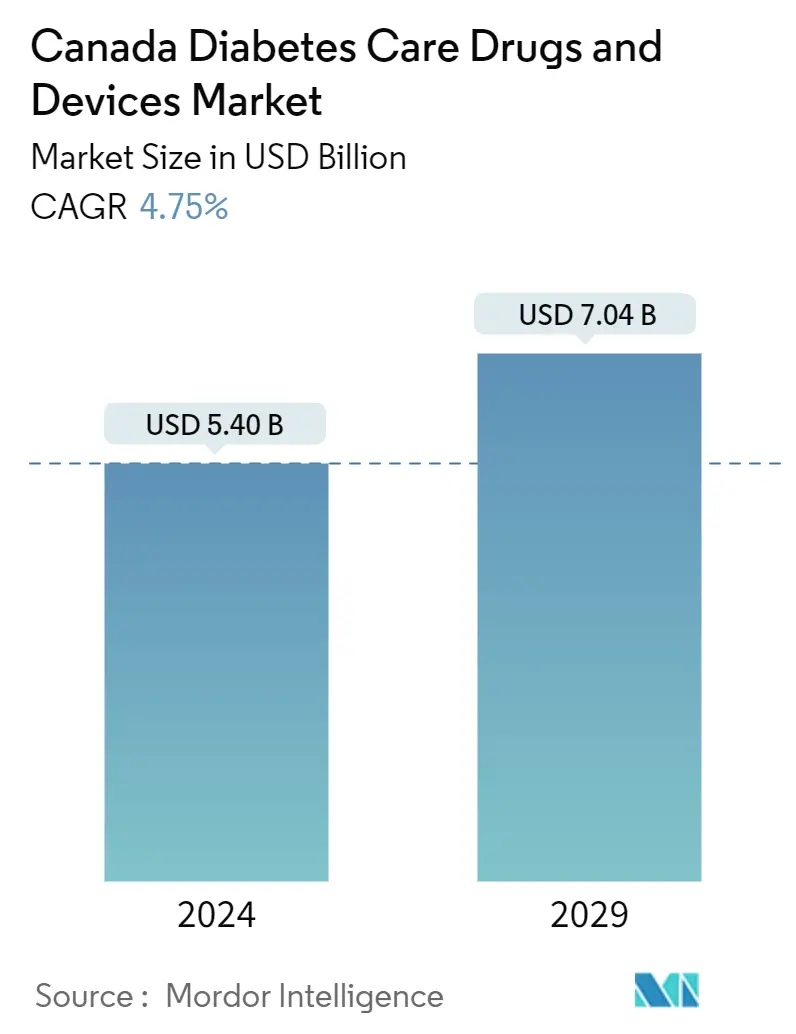
| Study Period | 2019 - 2029 |
| Base Year For Estimation | 2023 |
| Forecast Data Period | 2024 - 2029 |
| Market Size (2024) | USD 5.40 Billion |
| Market Size (2029) | USD 7.04 Billion |
| CAGR (2024 - 2029) | 4.75 % |
Major Players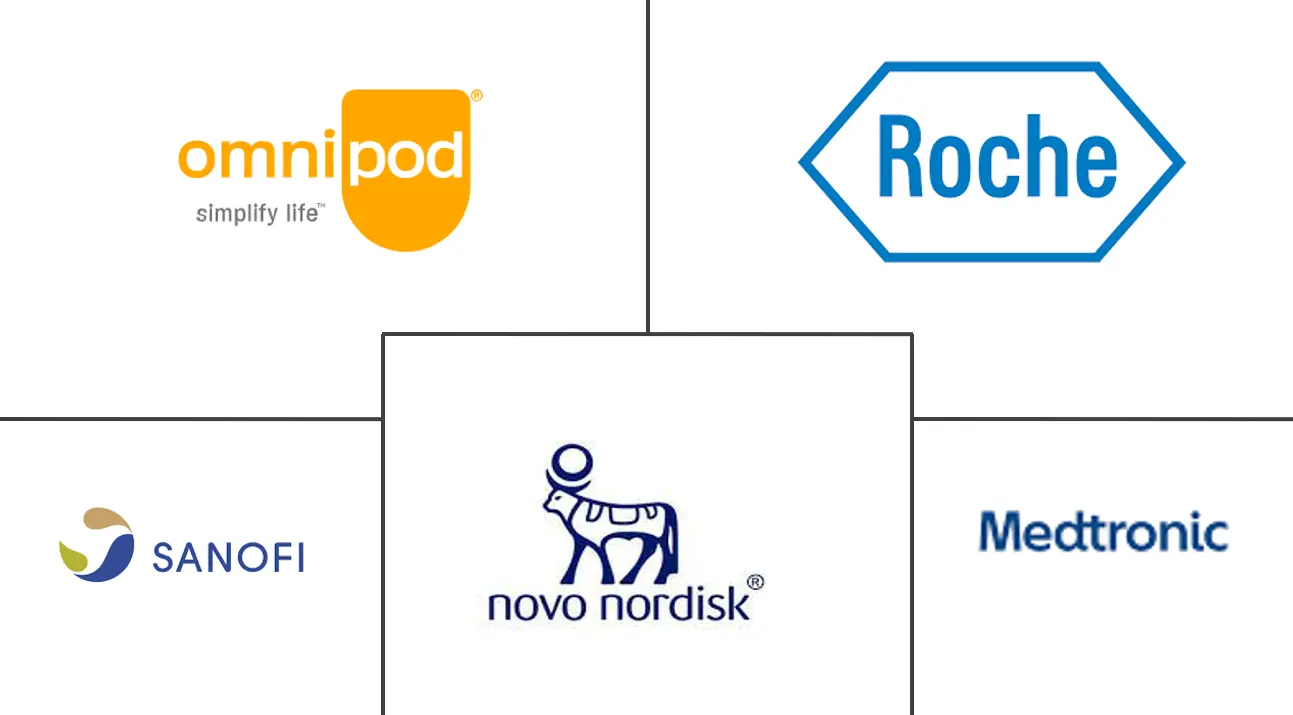
*Disclaimer: Major Players sorted in no particular order |
Canada Diabetes Care Drugs & Devices Market Analysis
The Canada Diabetes Care Drugs And Devices Market size is estimated at USD 5.40 billion in 2024, and is expected to reach USD 7.04 billion by 2029, growing at a CAGR of 4.75% during the forecast period (2024-2029).
In Canada, public health is overseen at the federal, provincial, and regional levels, and the Canadian constitution delegates healthcare authority to the country's ten provinces and three territories. As a result, like the United States, where individual states generally define the COVID-19 response, Canadian provinces mostly selected containment and mitigation plans. Provincial public health authorities collaborated closely with regional public health officers and municipal governments to develop policies and recommendations and put services like testing and contact tracing in place.
Blood pressure regulation was a critical component of diabetes management. Furthermore, even without high blood pressure, certain blood pressure-lowering medications were frequently recommended for people with diabetes to protect them from kidney and heart-related complications. No scientific evidence linked these blood pressure drugs to the likelihood of COVID-19 infection or associated consequences.
In Canada, during the pandemic, many healthcare providers have adopted a hybrid model of care, offering certain types of visits in-person at the clinic and others virtually, by phone, video chat, or secure messaging. Virtual diabetes care may be a new and different experience for you. For tips on preparing for your diabetes visit and managing virtual appointments. Yet, an insulin vial costs less than C$50 in Canada. More and more Americans are traveling up to the north in search of less expensive insulin to store up. Although importing unapproved medications from Canada is technically against the law, regulators often have no problem with people trying to save money while traveling. Those who import medicine for personal use in quantities less than three months "usually do not object," according to the FDA website.
Canada Diabetes Care Drugs & Devices Market Trends
The Continuous Glucose Monitoring Devices Segment is Growing at a Significant Pace
The Diabetes Canada Clinical Practice Guidelines review committee updated its recommendations for glucose monitoring in the current year, stating that individuals with Type 1 diabetes treated with basal-bolus insulin injections or an insulin pump should use real-time CGM, such as the Dexcom G6, to reduce A1C and increase time in range, reduce the duration and incidence of hypoglycemia, and, in adults, improve quality of life. 5 The guidelines also suggest that persons with type 2 diabetes who are not on target with basal-bolus insulin can utilize real-time CGM to lower A1C and duration of hypoglycemia.
Some private plans provide CGM coverage in Canada. However, public funding is only available for people accessing the Ontario Disability Support Program or the Non-Insured Health Benefits program for First Nations and Inuit. All others must pay the entire cost out-of-pocket, and there are no other provinces or territories that currently publicly fund this technology. CGM systems typically range in price from USD 3,000 to USD 6,000 annually. Many people cannot afford this cost. The cost can vary between manufacturers and is based on the components of the system and the frequency with which equipment needs to be replaced.
Through Canadian government encouragement, the usage of Continuous Glucose Monitoring Devices increased over the forecast period.
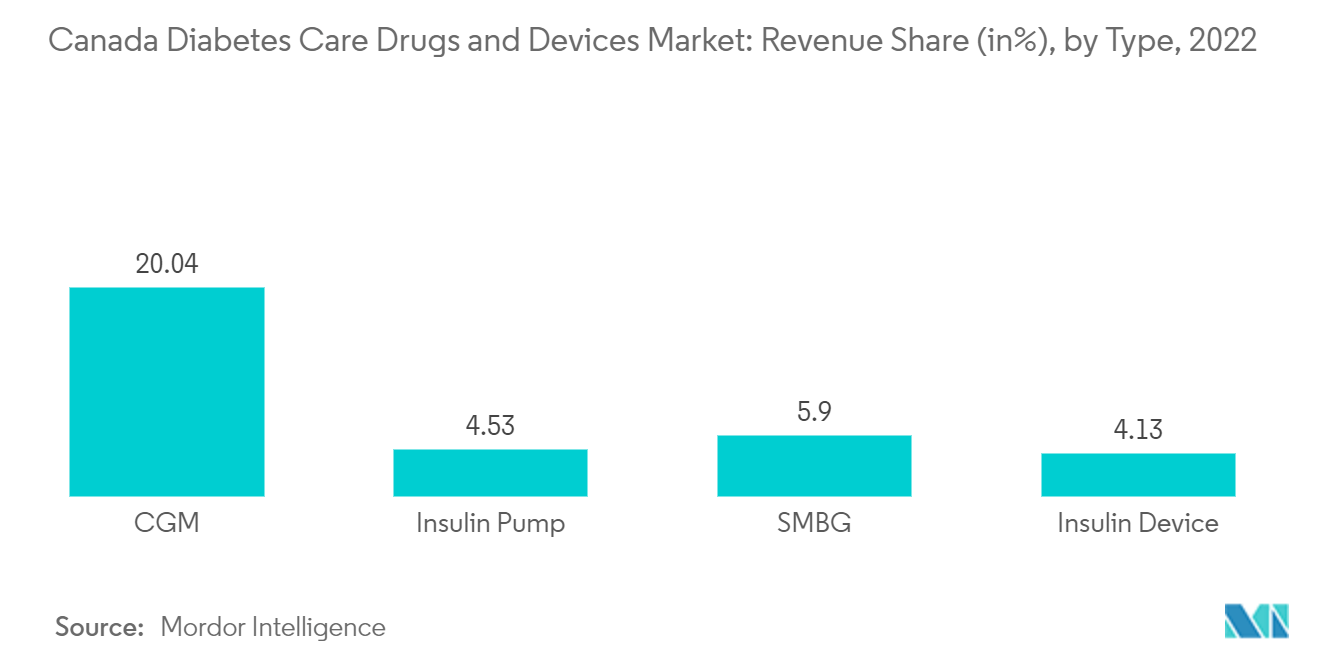
Increasing Diabetes population in Canada is Driving the Market
Diabetes Canada released new 2022 figures that show the continued rising trend of diabetes rates in Canada with no signs of leveling or decreasing. Diabetes affects more Canadians than ever and reasserts the need for further investment into diabetes research to help turn the tide. 'The new diabetes figures show a steady, continued increase in diabetes in our country with 11.7 million Canadians living with diabetes or prediabetes'.
Diabetes prevalence has increased dramatically in Canada during the last few decades, as have healthcare expenses. Financial constraints are becoming more prevalent when deciding how to fund health systems and services. Yet there must be a balance. Patients must continue to be at the forefront of choices about health policy, notwithstanding financial limitations.
Patients with diabetes should receive assistance in achieving their optimal health level, considering all relevant costs. In light of this, it may be beneficial to encourage insulin-naive patients to start using biosimilar insulin. When a patient's medical treatment is changed for factors other than their health and safety, this is known as non-medical switching.
In 2022, According to Canada Diabetes, more than 5.7 million Canadians are living with diagnosed diabetes (type 1 or type 2 diabetes). However, 11.7 million Canadians are living with diabetes or prediabetes, a condition that, if left unmanaged, can develop into type 2 diabetes. Diabetes also costs the healthcare system USD 30 billion annually to treat people with diabetes. The high prevalence of diabetes and its overwhelming impact on Canadian communities and the healthcare system means that we must further diabetes research.
Diabetes Canada and the Canadian Pharmacists Association (CPhA) are actively monitoring coronavirus issues, in collaboration with the Canadian local government and diabetes devices manufacturers, to remain available for all Canadians, and stated that 'based on the information from device manufacturers, there have been no COVID-19 related shortages reported in Canada'.
As a result, the diabetes drugs and devices market in Canada is predicted to expand gradually in the coming years.
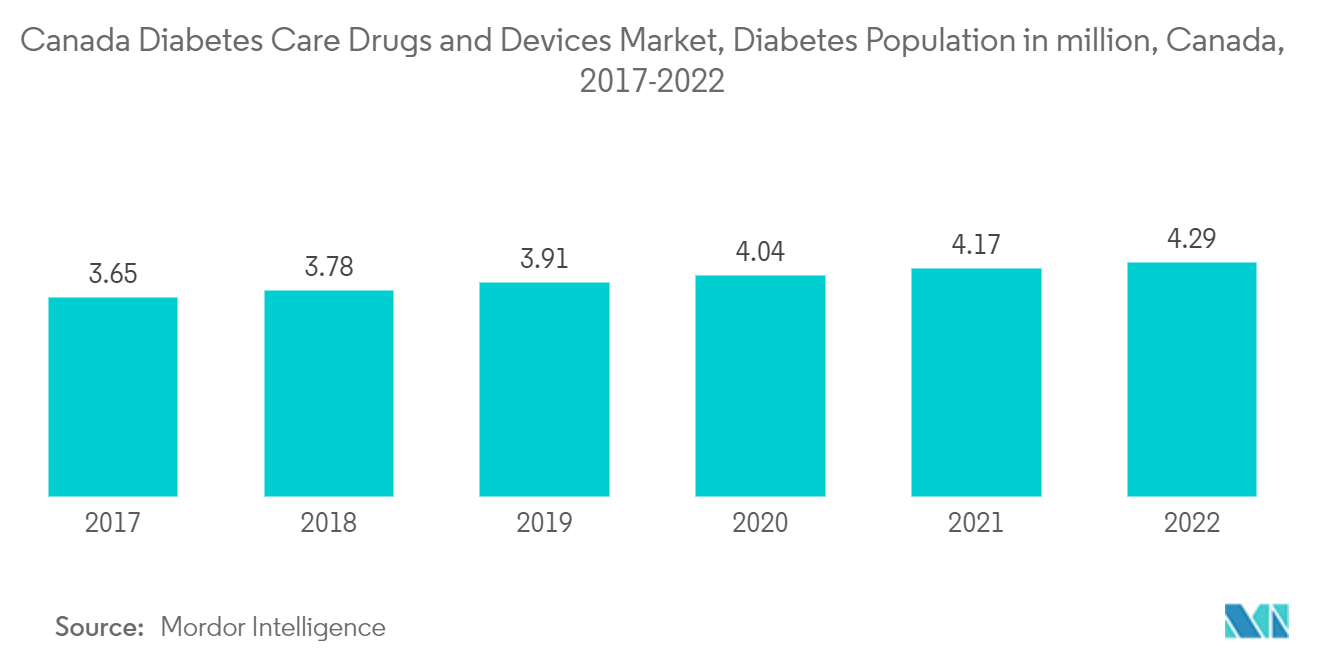
Canada Diabetes Care Drugs & Devices Industry Overview
Manufacturers have driven constant innovations to compete in the market. The major players, such as Abbott and Medtronic, have undergone many mergers, acquisitions, and partnerships to establish market dominance while also adhering to organic growth strategies, which is evident from the R&D spending of these companies. The manufacturers of insulin delivery devices are spending a massive amount on the R&D of the devices. For example, Novo Nordisk partnered with Abbott Diabetes Care, which may help to enable insulin data to be shared between Novo Nordisk-connected insulin pens and digital health tools compatible with the FreeStyle Libre portfolio of products. Mega Blockbuster Lantus, manufactured by Sanofi, led the basal insulin field.
Canada Diabetes Care Drugs & Devices Market Leaders
-
Roche
-
Medtrionic
-
Sanofi
-
Novo Nordisk
-
Omnipod
*Disclaimer: Major Players sorted in no particular order
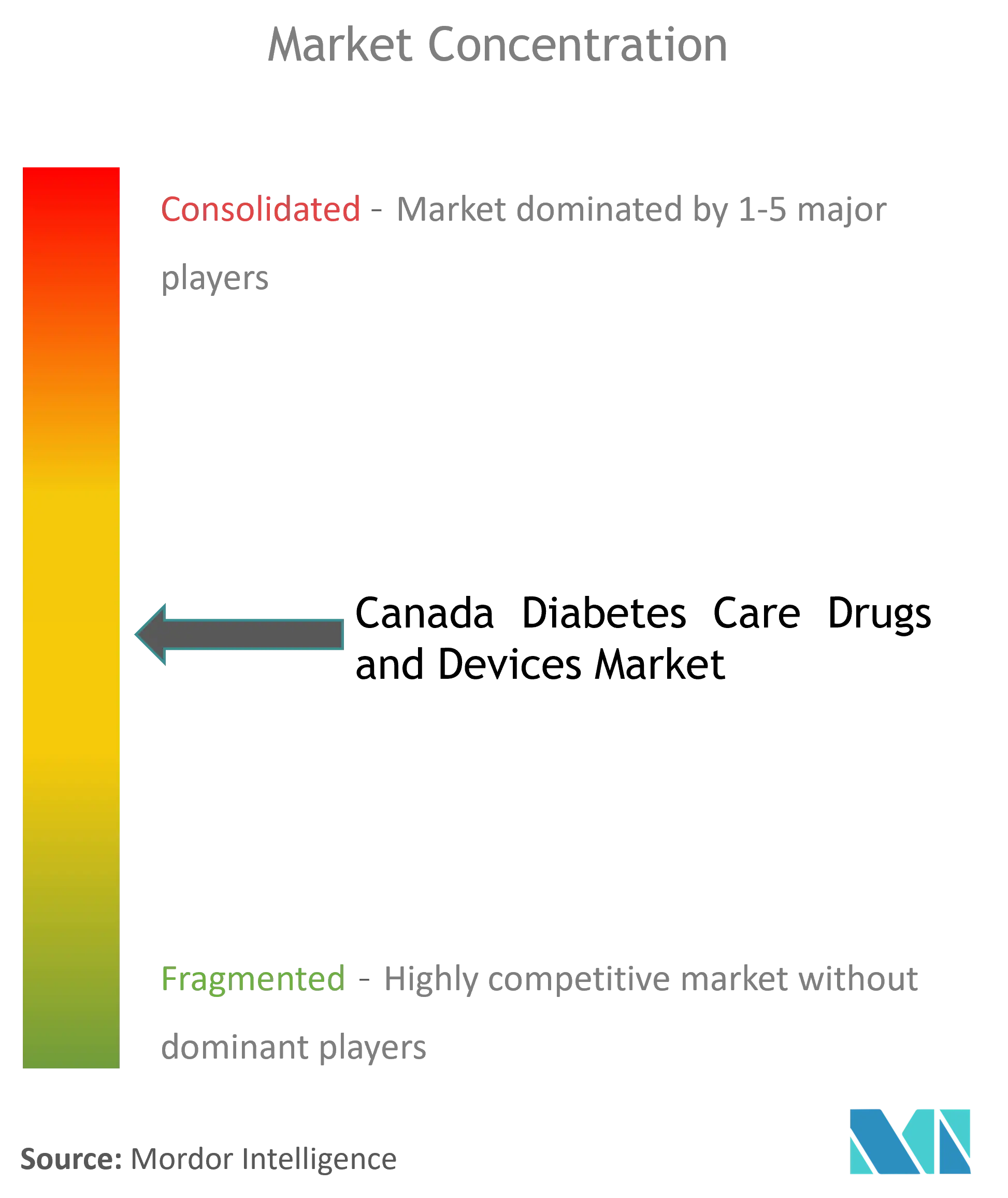
Canada Diabetes Care Drugs & Devices Market News
- July 2023: Dexcom, Inc. has received approval from Health Canada for their latest Dexcom G7 Continuous Glucose Monitoring System. This advanced system is designed for individuals with diabetes of all types, aged two years and above. Dexcom, Inc. specializes in manufacturing reliable continuous glucose monitoring solutions for people living with diabetes.
- July 2022: NuGen Medical Devices Inc. announced that its needle-free injection system and accessories, also known as InsuJet, have been approved by Health Canada specifically for needle-free insulin delivery. While NuGen previously announced on December 9, 2021, that its needle-free injection system had received general use approval from Health Canada, the insulin-specific approval is the first ever insulin-specific needle-free system approved by Health Canada to sell into the healthcare system and its end users. This approval may also aid in obtaining coverage for the system by certain healthcare insurance providers in Canada.
Canada Diabetes Care Drugs & Devices Market Report - Table of Contents
1. INTRODUCTION
- 1.1 Study Assumptions and Market Definition
- 1.2 Scope of the Study
2. RESEARCH METHODOLOGY
3. EXECUTIVE SUMMARY
4. MARKET DYNAMICS
- 4.1 Market Overview
- 4.2 Market Drivers
- 4.3 Market Restraints
-
4.4 Porter's Five Forces Analysis
- 4.4.1 Bargaining Power of Suppliers
- 4.4.2 Bargaining Power of Consumers
- 4.4.3 Threat of New Entrants
- 4.4.4 Threat of Substitute Products and Services
- 4.4.5 Intensity of Competitive Rivalry
5. Market Segmentation
-
5.1 Drug
- 5.1.1 Oral anti-diabetic drugs
- 5.1.1.1 Biguanide
- 5.1.1.1.1 Metformin
- 5.1.1.2 Alpha - Glucosidase inhibitors
- 5.1.1.2.1 Alpha - Glucosidase inhibitors
- 5.1.1.3 Dopamine -D2 receptor agonist
- 5.1.1.3.1 Bromocriptin( Cycloset)
- 5.1.1.4 Sodium - glucose cotransport -2 (SGLT-2) inhibitor
- 5.1.1.4.1 Invokana (Canagliflozin)
- 5.1.1.4.2 Jardiance (Empagliflozin)
- 5.1.1.4.3 Farxiga/Forxiga (Dapagliflozin)
- 5.1.1.4.4 Suglat (Ipragliflozin)
- 5.1.1.5 Dipeptidyl peptidase - 4 (DPP-4) inhibitors
- 5.1.1.5.1 Januvia (Sitagliptin)
- 5.1.1.5.2 Onglyza (Saxagliptin)
- 5.1.1.5.3 Tradjenta (Linagliptin)
- 5.1.1.5.4 Vipidia/Nesina (Alogliptin)
- 5.1.1.5.5 Galvus (Vildagliptin)
- 5.1.1.6 Sulfonylureas
- 5.1.1.6.1 Sulfonylureas
- 5.1.1.7 Meglitinide
- 5.1.1.7.1 Meglitinide
- 5.1.2 Insulin
- 5.1.2.1 Basal or Long Acting Insulins
- 5.1.2.1.1 Lantus (Insulin Glargine)
- 5.1.2.1.2 Levemir (Insulin Detemir)
- 5.1.2.1.3 Toujeo (Insulin Glargine)
- 5.1.2.1.4 Tresiba (Insulin Degludec)
- 5.1.2.1.5 Basaglar (Insulin Glargine)
- 5.1.2.2 Bolus or Fast Acting Insulins
- 5.1.2.2.1 NovoRapid/Novolog (Insulin Aspart)
- 5.1.2.2.2 Humalog (Insulin Lispro)
- 5.1.2.2.3 Apidra (Insulin Glulisine)
- 5.1.2.2.4 FIASP (Insulin Aspart)
- 5.1.2.3 Traditional Human Insulins
- 5.1.2.3.1 Novolin/Actrapid/Insulatard
- 5.1.2.3.2 Humilin
- 5.1.3 Combination Insulins
- 5.1.3.1 NovoMix (Biphasic Insulin Aspart)
- 5.1.3.2 Ryzodeg (Insulin Degludec and Insulin Aspart)
- 5.1.3.3 Xultophy (Insulin Degludec and Liraglutide)
- 5.1.3.4 Soliqua/Suliqua (Insulin Glargine and Lixisenatide)
- 5.1.4 Oral Combination
- 5.1.4.1 Janumet (Sitagliptin and Metformin HCl)
- 5.1.5 Non-Insulin Injectable drugs
- 5.1.5.1 GLP1 receptor agonists
- 5.1.5.1.1 Victoza (Liraglutide)
- 5.1.5.1.2 Byetta (Exenatide)
- 5.1.5.1.3 Bydureon (Exenatide)
- 5.1.5.1.4 Trulicity (Dulaglutide)
- 5.1.5.1.5 Lyxumia (Lixisenatide)
- 5.1.5.2 Amylin Analogue
- 5.1.5.2.1 Symlin (Pramlintide)
-
5.2 Devices
- 5.2.1 Monitoring Devices
- 5.2.1.1 Self-Monitoring Blood Glucose
- 5.2.1.1.1 Glucometer Devices
- 5.2.1.1.2 Blood Glucose Test Strips
- 5.2.1.1.3 Lancets
- 5.2.1.2 Continuous Glucose Monitoring
- 5.2.1.2.1 Sensors
- 5.2.1.2.2 Durables
- 5.2.2 Management Devices
- 5.2.2.1 Insulin Pump
- 5.2.2.1.1 Insulin Pump Device
- 5.2.2.1.2 Insulin Pump Reservoir
- 5.2.2.1.3 Infusion Set
- 5.2.2.2 Insulin Syringes
- 5.2.2.3 Cartridges in Reusable pens
- 5.2.2.4 Insulin Disposable Pens
- 5.2.2.5 Jet Injectors
6. MARKET INDICATORS
- 6.1 Type-1 Diabetic Population
- 6.2 Type-2 Diabetic Population
7. COMPETITIVE LANDSCAPE
-
7.1 Company Profiles
- 7.1.1 Novo Nordisk A/S
- 7.1.2 Sanofi Aventis
- 7.1.3 Eli Lilly
- 7.1.4 AstraZeneca
- 7.1.5 AstraZeneca
- 7.1.6 Boehringer Ingelheim
- 7.1.7 Bristol Myers Squibb
- 7.1.8 Roche
- 7.1.9 Abbott
- 7.1.10 Johnson and Johnson (Lifescan)
- 7.1.11 Arkray
- 7.1.12 Ascensia Diabetes Care
- 7.1.13 AgaMatrix Inc.
- 7.1.14 Dexcom
- 7.1.15 Medtronic
- 7.1.16 Becton Dickinson
- 7.1.17 Ypsomed Holding AG
- 7.1.18 Ypsomed Holding AG
- 7.1.19 Terumo
- 7.1.20 LMC Diabetes and Endocrinology
- 7.1.21 Bayshore Health Care
- 7.1.22 Express Scripts
- 7.1.23 One Drop
- 7.1.24 Telus Health
- *List Not Exhaustive
- 7.2 Company Share Analysis
8. MARKET OPPORTUNITIES AND FUTURE TRENDS
** Subject To AvailablityCanada Diabetes Care Drugs & Devices Industry Segmentation
Canada Diabetes Care Drugs and Devices Market witnessed USD 4.7 billion in the current year and is anticipated to register a CAGR of over 4% during the forecast period. The Canada Diabetes Care Drugs and Devices Market is segmented into Drugs (by Category (Insulin, Oral Anti-Diabetic Drugs, Non-Insulin Injectable Drugs, and Combination Drugs), by sub-segment (Basal or Long-acting, Bolus or Fast-acting, Traditional Human Insulin Drugs, Insulin Biosimilars, GLP-1 Receptor Agonists, Alpha-Glucosidase Inhibitors, DPP-4 Inhibitors, and SGLT-2 Inhibitors)) and Devices (Management Devices (Insulin Pumps, Insulin Pens, Syringes, Cartridges, and Jet Injectors) and Monitoring Devices (Self-monitoring Blood and Continuous Glucose Monitoring)). The report offers the market size in value terms in USD for all the abovementioned segments.
| Drug | Oral anti-diabetic drugs | Biguanide | Metformin |
| Drug | Oral anti-diabetic drugs | Alpha - Glucosidase inhibitors | Alpha - Glucosidase inhibitors |
| Drug | Oral anti-diabetic drugs | Dopamine -D2 receptor agonist | Bromocriptin( Cycloset) |
| Drug | Oral anti-diabetic drugs | Sodium - glucose cotransport -2 (SGLT-2) inhibitor | Invokana (Canagliflozin) |
| Jardiance (Empagliflozin) | |||
| Farxiga/Forxiga (Dapagliflozin) | |||
| Suglat (Ipragliflozin) | |||
| Drug | Oral anti-diabetic drugs | Dipeptidyl peptidase - 4 (DPP-4) inhibitors | Januvia (Sitagliptin) |
| Onglyza (Saxagliptin) | |||
| Tradjenta (Linagliptin) | |||
| Vipidia/Nesina (Alogliptin) | |||
| Galvus (Vildagliptin) | |||
| Drug | Oral anti-diabetic drugs | Sulfonylureas | Sulfonylureas |
| Drug | Oral anti-diabetic drugs | Meglitinide | Meglitinide |
| Drug | Insulin | Basal or Long Acting Insulins | Lantus (Insulin Glargine) |
| Levemir (Insulin Detemir) | |||
| Toujeo (Insulin Glargine) | |||
| Tresiba (Insulin Degludec) | |||
| Basaglar (Insulin Glargine) | |||
| Drug | Insulin | Bolus or Fast Acting Insulins | NovoRapid/Novolog (Insulin Aspart) |
| Humalog (Insulin Lispro) | |||
| Apidra (Insulin Glulisine) | |||
| FIASP (Insulin Aspart) | |||
| Drug | Insulin | Traditional Human Insulins | Novolin/Actrapid/Insulatard |
| Humilin | |||
| Drug | Combination Insulins | NovoMix (Biphasic Insulin Aspart) | |
| Ryzodeg (Insulin Degludec and Insulin Aspart) | |||
| Xultophy (Insulin Degludec and Liraglutide) | |||
| Soliqua/Suliqua (Insulin Glargine and Lixisenatide) | |||
| Drug | Oral Combination | Janumet (Sitagliptin and Metformin HCl) | |
| Drug | Non-Insulin Injectable drugs | GLP1 receptor agonists | Victoza (Liraglutide) |
| Byetta (Exenatide) | |||
| Bydureon (Exenatide) | |||
| Trulicity (Dulaglutide) | |||
| Lyxumia (Lixisenatide) | |||
| Drug | Non-Insulin Injectable drugs | Amylin Analogue | Symlin (Pramlintide) |
| Devices | Monitoring Devices | Self-Monitoring Blood Glucose | Glucometer Devices |
| Blood Glucose Test Strips | |||
| Lancets | |||
| Devices | Monitoring Devices | Continuous Glucose Monitoring | Sensors |
| Durables | |||
| Devices | Management Devices | Insulin Pump | Insulin Pump Device |
| Insulin Pump Reservoir | |||
| Infusion Set | |||
| Devices | Management Devices | Insulin Syringes | |
| Cartridges in Reusable pens | |||
| Insulin Disposable Pens | |||
| Jet Injectors |
Canada Diabetes Care Drugs & Devices Market Research FAQs
How big is the Canada Diabetes Care Drugs And Devices Market?
The Canada Diabetes Care Drugs And Devices Market size is expected to reach USD 5.40 billion in 2024 and grow at a CAGR of 4.75% to reach USD 7.04 billion by 2029.
What is the current Canada Diabetes Care Drugs And Devices Market size?
In 2024, the Canada Diabetes Care Drugs And Devices Market size is expected to reach USD 5.40 billion.
Who are the key players in Canada Diabetes Care Drugs And Devices Market?
Roche, Medtrionic, Sanofi, Novo Nordisk and Omnipod are the major companies operating in the Canada Diabetes Care Drugs And Devices Market.
What years does this Canada Diabetes Care Drugs And Devices Market cover, and what was the market size in 2023?
In 2023, the Canada Diabetes Care Drugs And Devices Market size was estimated at USD 5.14 billion. The report covers the Canada Diabetes Care Drugs And Devices Market historical market size for years: 2019, 2020, 2021, 2022 and 2023. The report also forecasts the Canada Diabetes Care Drugs And Devices Market size for years: 2024, 2025, 2026, 2027, 2028 and 2029.
Canada Diabetes Care Drugs and Devices Industry Report
Statistics for the 2024 Canada Diabetes Care Drugs and Devices market share, size and revenue growth rate, created by Mordor Intelligence™ Industry Reports. Canada Diabetes Care Drugs and Devices analysis includes a market forecast outlook to 2029 and historical overview. Get a sample of this industry analysis as a free report PDF download.



